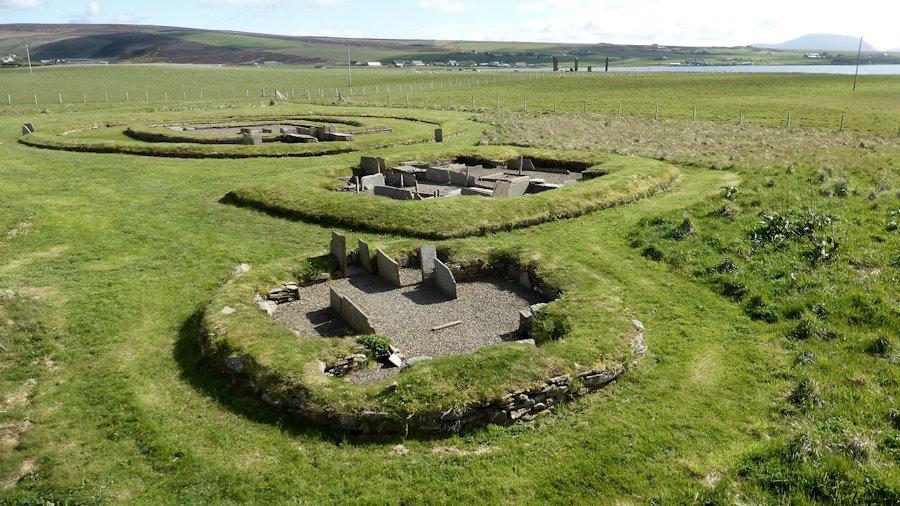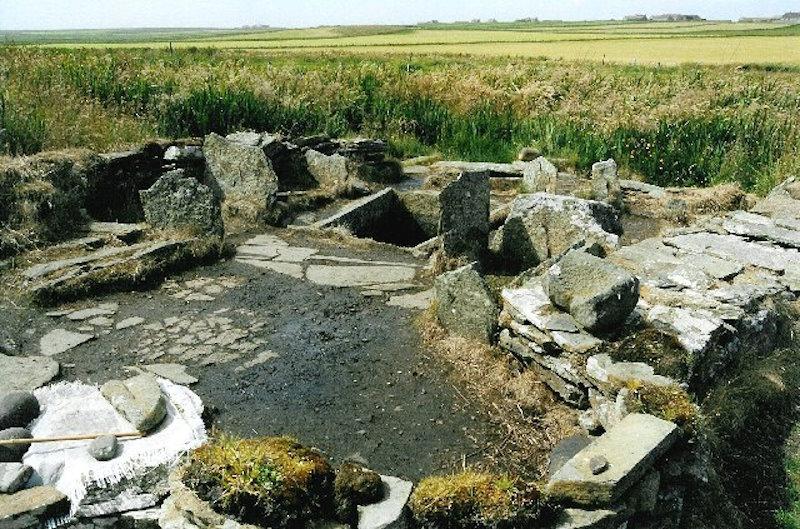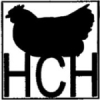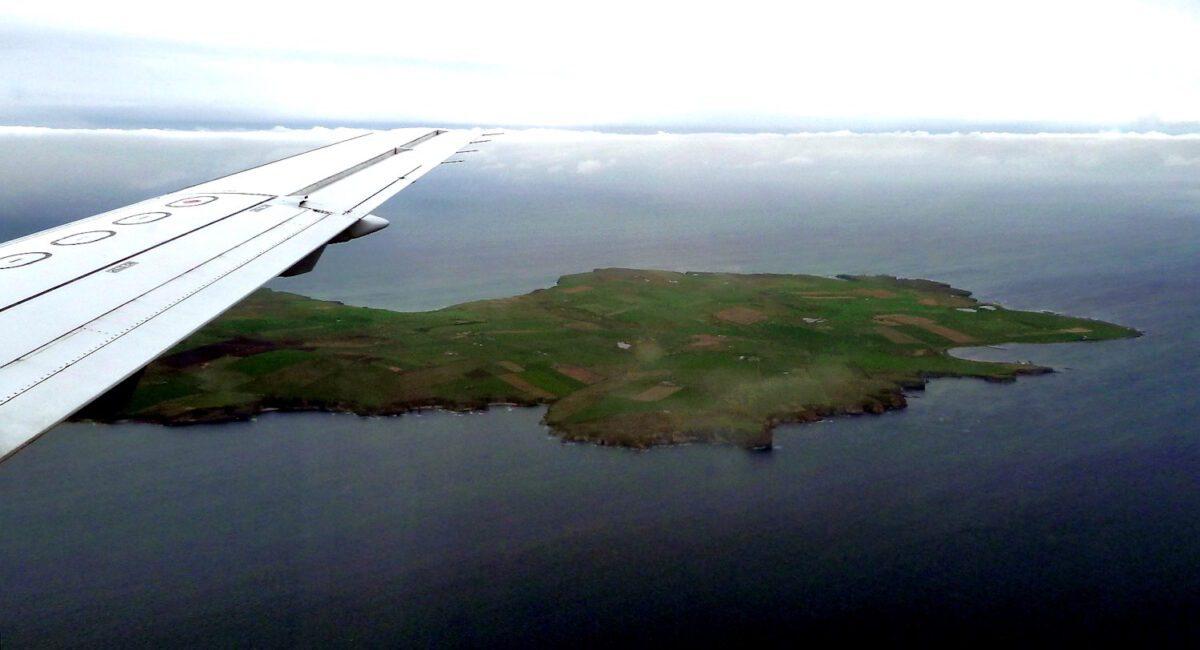Jump to different periods: Welcome | Palaeolithic and Mesolithic (11000-4000 BCE) | Neolithic (4000- 2000 BCE) | Bronze Age (2,000 – 900 BCE) | Iron Age (900 BCE to CE 43) | Pictish (43 – 800 CE) | Viking / Norse / Scandinavian (800 -1472 CE) | Scottish and British rule (1472 CE- )
Page under construction
Welcome
Burray and South Ronaldsay have played an important role in Orkney’s history and development. For example, Old St Mary’s Church aka Lady Kirk in Burwick (pictured above) marks where the first Christian missionaries are said to have landed in what we now know as Orkney. Thousands of years before that people were being buried nearby in the Tomb of the Eagles and we see the development of farming. The North Sea laps their eastern coastlines, the natural harbour of Scapa Flow lies to their west, and the Pentland Firth flows past the south of South Ronaldsay (on the right of the picture above). As a result, the islands became significant destinations for shipping and industries linked to the sea.
On this page, we provide an outline of what has happened in the islands over the last 13,000 years or so. On two further pages, we highlight places that have been part of that story [exploring Burray | exploring South Ronaldsay].
The Palaeolithic (14000-9000 BCE) and Mesolithic Periods (9000-4000 BCE)
For many years it was thought that the human history of Orkney began around 6000 BCE i.e. in the Mesolithic Period. However, there is growing evidence from archaeological research (such as that at the Ness of Brodgar) that, in Orkney, human activity looks to have been present around 11,000 BCE i.e. in the Palaeolithic Period. As the Ice Age closed, people arrived in Orkney.
Sea levels were up to 20 metres lower in the Mesolithic Period. Consequently, the East of England was connected to what we now know as mainland Europe and islands like Burray, South Ronaldsay and Hoy were part of the Orkney mainland. As a result, there was just one narrow entrance to Scapa Flow with South Ronaldsay’s Hoxa Head on one side and a closer Flota on the other.
The people who came to live here were nomadic hunter-gatherers – so there is limited physical evidence of their presence. Later, the shift to farming made a huge difference in this respect.
The Neolithic Period (around 4000 BCE to 2000 BCE)
We know farming was developing across many of the islands in the Neolithic period. The oldest preserved stone house in Orkney (and northern Europe) dates from around 3700 BCE and was part of a farmstead at the Knap of Howar on the island of Papa Westray. There is also evidence of the cultivation of crops and the raising of livestock on other islands. In Orkney’s west mainland, we find the most complete Neolithic village in Europe. It is situated beside the Bay of Skaill at Skara Brae and was in use from around 3180 BCE. Another cluster of buildings from the same time was found nearby. Close to the shore of Loch of Harray and known as the Barnhouse Settlement, it is not far from the Standing Stones of Stenness (as seen in the picture below).

In South Ronaldsay, we can also see evidence of Neolithic life. For example, The Tomb of the Eagles (aka Isbister Chambered Tomb) contains human remains and artefacts from over 5,000 years ago. Some of these can be viewed at the Orkney Museum in Kirkwall – The Tomb of the Eagles is currently closed.
The Bronze Age (2,000 BCE to 900 BCE)
Across Orkney, there is evidence that farmsteads flourished as we entered the Bronze Age (2,000 BCE to 900 BCE). One result was that there appears to have been significant immigration around this time – particularly of women. (The ‘immigration’ that took place might have been similar to what occurred later in Viking times. Then sexual slavery and large-scale movement of women were a common occurrence).
Close to the Tomb of the Eagles, we find one of the best examples of a Bronze Age burnt mound or cooking/washing place in Orkney. There are said to be over 200 burnt mound sites on the islands.

The washing/cooking area was constructed with flat slabs (and sealed with clay). It is suggested that the water was probably heated by stones warmed by burning peat [click for more information].
The Iron Age (900 BCE to CE 43)
By the Iron Age, Orkney had developed a robust agricultural system that involved mixed farming, growing cereals like barley and wheat, and rearing sheep and cattle. Various tools have survived from this period including bone combs used in weaving and quernstones for grinding grain. There are also examples of pottery ware. In terms of buildings, one of the most visible examples is brochs – round towers (broch is said to derive from ‘brough’ a Lowland Scots word used for forts). However, more recent work suggests they were often used for residential rather than defensive purposes.
Brochs started appearing around 300 BCE and the highest concentration of such buildings is in Orkney, Shetland and north Caithness. Two classic examples can be found in South Ronaldsay – one at the Cairns dig at Windwick Bay, another at Hoxa – the Howe of Hoxa. A second development was Weems – underground houses. ‘Weem’ is said to be derived from the Gaelic word ‘uamh’, meaning cave. However, just to add to the confusion, South Ronaldsay has Weems Castle, which looks to be the ruins of a broch (click for map). Unfortunately, not much is known about the culture and language of Orkney’s residents during this time.
The Pictish Period (43 CE – 800 CE)
A common way of discussing the next stage in Scottish history is describing it as the ‘Roman Period’ (43 CE – 411 CE). The problem with this for the Northern Isles and much of the mainland is that Roman armies and governance never reached them. Some Romans may have visited Orkney, for example, to trade, but not to occupy. Instead, it is more accurate to talk about the Pictish Period and the activities of a group of tribes who largely spoke in a Celtic language but left no written records. The dates we give here of 43 CE – 800 CE are, thus, rough and ready.
The first written mention of the Picts was Roman and involved their role in the battle of Mons Graupius in c.80 CE. Their original name might have been something like Pecht (which can be translated to ‘the ancestor peoples’). In recent years, genetic studies suggest there wasn’t a single Celtic or Pictish group but various strands. It is now possible to talk about a genetic basis for regional identities. Picts were not the product of large-scale migration. In Orkney, there appears to have been Pictish genetic continuity since the end of the Iron Age. This is interesting given the invasion of the islands by Vikings. Norse DNA is significant – it appears to have contributed to about 25% of Orcadian DNA – but Pictish and other earlier strands remain strong.

Archaeological research shows Picts were largely farmers. They often lived in villages. However, we also know that some were hunters and others seafarers and warriors. From the number of symbol stones that have been discovered over the years, we also know that they were skilled in crafts. Indeed, Pictish stones have become one of the lasting and distinctive features of these times.
There are something like 350 Pictish stones carved with symbols and/or designs listed in Scotland. Orkney has been home to eight accomplished Pictish symbol-bearing stones, four small stones with rough versions of symbols, sixteen or seventeen cross-slabs of different kinds and two pieces of church furniture. Unfortunately, in Orkney, Shetland and Caithness, no stone with symbols has survived upright in the landscape. Some have been found at the likely place of origin. St Peter’s Church, South Ronaldsay had a fascinating symbol stone carved on both sides (possibly because it was reused). It was then reused again to form part of an east-facing window in the church and subsequently removed to the National Museum of Antiquities of Scotland in Edinburgh. The one carved and probably Pictish stone left on the island is at Old St Mary’s, Burwick. Known as the Ladykirk Stone, it is a rounded grey whin stone carved with two footprints. It is said to be a Pictish coronation stone. Click to see. What we do not know is the meaning of many of the symbols that have been discovered.
The use of symbols wasn’t confined to stones at least in folklore. Picts have, fairly often, been represented as having bodies covered with tattoos. This is not something that we can confirm. In recent years, we have learnt more about other aspects of their lives. For example, the discovery of the bridge from a 400 BC lyre in Skye suggests music may have been, for some, a part of their lives.
The contemporary written material we have is overwhelmingly from non-Picts who may want to put their own spin on what they report and is mostly not original but ‘copies of copies’. As Sally M Foster has pointed out:
Only one text of any kind can fairly be claimed as Pictish, the so-called king list, which give lengths of reigns. Two versions exist, neither of which are in a manuscript older than the 14th century and one of which is heavily gaelicised. [Picts, Gaels and Scots, 2014]
The Viking / Norse / Scandinavian Period (800 CE-1472 CE)
While Viking and Norse are often used interchangeably – there is an underlying difference. The term ‘Viking’ is from ‘Old Norse’ and was often used to describe ‘pirate’ raids and later, also, to talk about those involved in sailing longboats from Scandinavia (broadly what we now know as Norway, Sweden and Denmark) to other areas to explore, trade/raid and settle. ‘Norse’ refers here both to a North Germanic language (Old Norse) and to the Scandinavians who were living and working in Norway, Sweden and Denmark. ‘Old Norse’ was in widespread use from about the 9th to the 13th centuries. In other words, what we see are raiders and settlers.
The Danes broadly sailed to, and took over, a great swathe of what we now know as the north and east of England in the late 9th Century. Later known as Danelaw this area stretching from London to York and across to Lancashire had to abide by Danish Law. Northumbria was raided but not occupied in this way. Swedish raiders hit the more northerly areas like Jórvík (now York) and, along with the Norwegians, parts of Scotland and the Northern Isles. So it was, that from around 800 CE to 1468/72 CE significant areas of what we now know as Scotland were colonised by Norwegians and were helped in this by other Scandinavians. ‘Scandinavian Scotland’ included Iona (first raided in 794 CE, and abandoned fifty years later) and the Hebrides came effectively under the control of the King of Norway – as did Shetland and Orkney. These islands were, thus, essentially under the control of Norway for longer than they have been part of Scotland.
Language and name changes
long with North Ronaldsay, the island is named after St Ronald. The original name from which the English name derives, Rǫgnvaldsey, comes from Old Norse; Rǫgnvalds (“Ronald’s”) + ey (“island”).
Settlement
Farming
remained a cornerstone of Orkney’s economy throughout the Viking Age and beyond. The Norse settlers introduced new methods and livestock breeds, leaving a lasting influence on the islands’ farming culture. Orkney’s isolation from mainland Scotland helped preserve many traditional farming methods, which are still visible in the island’s landscape and the daily routines of its farmers”
Add in bit about
Margaret, Maid of Norway link to Wikipedia
Halcro’s etc.

